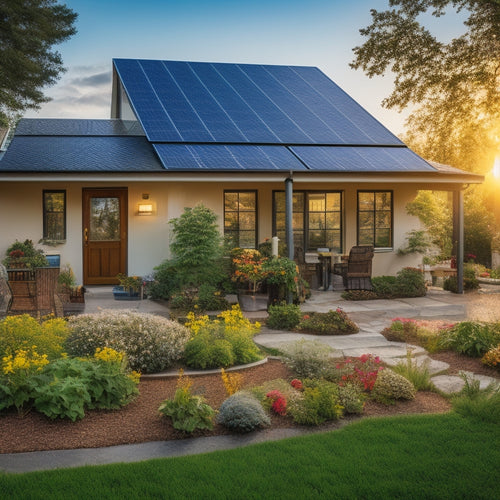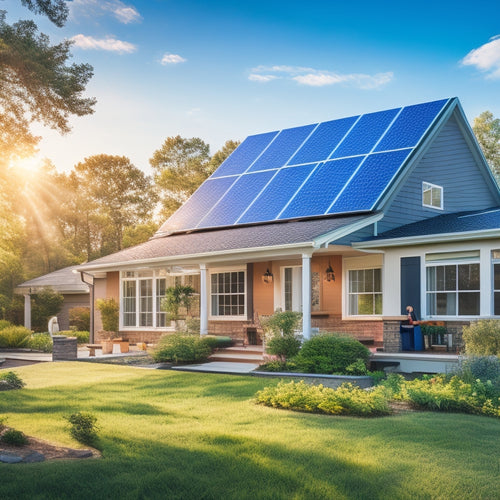
Top 5 Commercial Solar Panel Financing Options
Share
To finance your commercial solar panel systems, consider these data-backed options: Power Purchase Agreements (PPAs) let you install solar systems with lower rates and stable prices over 10-25 years. With Solar Leases, you pay a fixed monthly fee, simplifying budgeting and including maintenance. Commercial Solar Loans offer flexible terms and leverage tax benefits directly. Property Assessed Clean Energy (PACE) programs fund installations through property taxes, with long repayment terms and local incentives. Lastly, Solar Investment Tax Credits reduce upfront costs by 26%, subject to eligibility. Understanding these can greatly enhance your energy and cost efficiency.
Key Takeaways
- Power Purchase Agreements offer lower rates than grid electricity and price stability over 10 to 25 years.
- Solar Leases provide fixed monthly payments and include maintenance and monitoring for substantial savings over 10 to 25 years.
- Commercial Solar Loans offer flexible terms of 5 to 20 years with competitive interest rates and direct access to energy savings and tax incentives.
- Property Assessed Clean Energy funding integrates solar installation costs into property tax bills with long repayment terms and is transferable.
- Solar Investment Tax Credits offer a 26% federal tax credit, reducing upfront costs and requiring eligibility and application via IRS Form 3468.
Power Purchase Agreements
Power Purchase Agreements (PPAs) allow you to enjoy the benefits of solar energy without the upfront costs or maintenance responsibilities. By entering into a PPA, you agree to buy the electricity generated by a solar energy system installed on your property, typically at a rate lower than what you currently pay for grid electricity. This arrangement can lead to significant energy savings over the duration of the contract.
PPAs usually span 10 to 25 years, offering long-term price stability and protection against rising energy costs. The contract terms are critical; they dictate your cost per kilowatt-hour (kWh), annual price escalations, and potential buyout options. Careful analysis of these terms can guarantee that the PPA aligns with your financial and operational goals.
Data shows that businesses can save up to 20% on their electricity bills through PPAs. Monitoring these savings is straightforward, as detailed monthly statements provide transparency. Remember, the provider is responsible for system maintenance and performance, ensuring you won't incur additional costs.
A well-structured PPA not only offers immediate financial benefits but also supports your sustainability initiatives without capital investment, making it a compelling option for commercial solar panel financing.
Solar Leases
Similar to PPAs, solar leases offer a cost-effective way to access solar energy without the initial capital outlay, enabling businesses to lease the solar panel system and pay a fixed monthly fee for its use. This financing model is particularly important for businesses that prefer predictable expenses. When you lease a solar system, you're basically renting the equipment from a solar provider for a set period, typically ranging from 10 to 25 years.
Analyzing the payment terms, you'll find that most solar leases come with fixed monthly payments, allowing you to budget accurately without worrying about fluctuating energy costs. Some leases also include maintenance and monitoring, providing additional peace of mind. Contract length is a vital factor; shorter contracts might offer more flexibility, but longer ones often come with better rates.
Data shows that businesses can save significantly on energy costs over the lease term. For instance, a 20-year lease can result in substantial savings, even when accounting for the monthly lease payment.
Reviewing these aspects in detail can help you make an informed decision, ensuring the solar lease aligns with your financial and operational goals.
Commercial Solar Loans
Commercial solar loans provide businesses with the capital needed to purchase solar panel systems outright, enabling them to own the equipment and benefit directly from energy savings and tax incentives. These loans typically come with competitive interest rates and flexible loan terms, making them an attractive option for companies looking to invest in renewable energy.
When considering a commercial solar loan, you'll want to closely examine the interest rates offered by different financial institutions. Interest rates can vary greatly, and even a small difference can have a substantial impact on your overall cost. Lower interest rates generally mean lower monthly payments and less paid in interest over the life of the loan.
Loan terms are another important factor. Most commercial solar loans have terms ranging from 5 to 20 years. Shorter loan terms may result in higher monthly payments but reduce the total interest paid. Conversely, longer loan terms can offer lower monthly payments but may accrue more interest over time.
It's essential to perform a cost-benefit analysis to determine the most advantageous loan structure for your business. By carefully evaluating interest rates and loan terms, you can secure a financial arrangement that maximizes your energy savings and tax benefits while minimizing your financial burden.
Property Assessed Clean Energy
Property Assessed Clean Energy (PACE) financing allows businesses to fund solar panel installations through an assessment added to their property tax bill, leveraging the property's value to secure the investment. This method reduces the upfront costs typically associated with solar projects, making it an attractive option for many businesses.
Here are four compelling reasons to ponder PACE financing:
-
Energy Savings: By installing solar panels, you'll reduce your energy bills by a large margin. The savings often outweigh the additional property tax assessment, leading to a net positive cash flow.
-
Local Incentives: Many local governments offer incentives for businesses that adopt clean energy solutions. These can include grants, tax breaks, or rebates, further reducing the overall cost of your solar investment.
-
Long-term Financing: PACE financing typically offers long repayment terms, often spanning 20 years or more. This allows you to spread the cost over an extended period, minimizing the immediate financial impact.
- Transferable Assessments: If you sell your property, the PACE assessment can be transferred to the new owner. This feature makes it easier to invest in solar without worrying about long-term commitments.
Solar Investment Tax Credits
Solar Investment Tax Credits (ITCs) provide a substantial financial incentive for businesses to invest in solar energy by offering a federal tax credit equal to a percentage of the cost of installing a solar energy system. The ITC rate currently stands at 26%, but it's important to stay updated as this percentage is subject to change. This tax credit can greatly reduce your upfront investment costs, making solar energy more accessible and financially viable.
To qualify for the ITC, you must meet specific eligibility criteria. Your solar energy system must be located in the United States and commence construction before December 31, 2024. Additionally, the system must meet performance and quality standards established by the IRS. Make sure you own the solar energy system outright; leasing arrangements don't qualify for the ITC.
The application process for the ITC is straightforward but requires attention to detail. You'll need to complete IRS Form 3468, which should be submitted along with your annual tax return. Keep meticulous records of all installation costs and related expenses to substantiate your claim.
Frequently Asked Questions
How Do I Determine the Optimal Size of a Solar Panel System for My Business?
To determine the most suitable size of your solar panel system, analyze your business's energy consumption and available roof space. Use data on your past energy bills and roof dimensions to calculate the required panel capacity accurately.
What Are the Maintenance Responsibilities Associated With Commercial Solar Panels?
You might think maintenance is overwhelming, but it's achievable. You'll need regular panel cleaning to guarantee efficiency and occasional inverter maintenance to avoid system downtime. Data shows these steps boost energy output and reduce long-term costs.
How Long Does the Installation Process for Commercial Solar Panels Typically Take?
The installation timeline for commercial solar panels typically ranges from one to three months. Your contractor selection greatly influences this duration, so choose a reliable, experienced team to guarantee efficiency and adherence to schedule.
Are There Any Potential Risks or Downsides to Installing Commercial Solar Panels?
Did you know that 20% of solar installations face system compatibility issues? This can lead to efficiency drops. Aesthetic concerns also arise, as panels might not blend with existing architecture, impacting property appearance and value.
How Can I Calculate the Long-Term Return on Investment for Commercial Solar Panels?
To calculate your long-term return on investment for commercial solar panels, determine your payback period by comparing the initial costs to projected energy savings. Factor in maintenance costs, incentives, and potential increases in energy prices.
Conclusion
By choosing the right commercial solar panel financing option—whether through Power Purchase Agreements, Solar Leases, Commercial Solar Loans, Property Assessed Clean Energy, or Solar Investment Tax Credits—you'll maximize savings, boost sustainability, and enhance energy independence.
Each method offers unique benefits, but all contribute to reducing energy costs and carbon footprint. Analyze your business needs, compare the data, and select the option that aligns best with your financial and environmental goals.
Investing in solar is smart, strategic, and sustainable.
Related Posts
-

Energy-Efficient Lighting Solutions for Sustainable Buildings
For sustainable buildings, energy-efficient lighting solutions, like LEDs, offer multiple benefits. These bulbs last ...
-

How to Achieve Energy Independence at Home
To achieve energy independence at home, start by investing in renewable energy sources like solar panels, wind turbin...
-

Solar Energy Grants and Incentives for Homeowners
Maneuvering solar energy grants and incentives is essential for reducing your installation costs. You can benefit fro...


